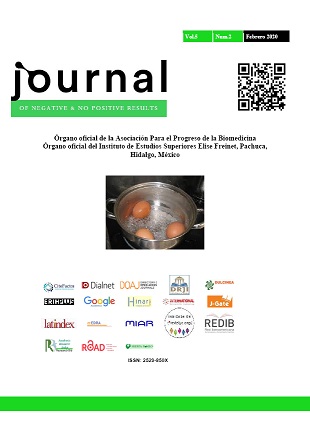Six weeks of physical exercise improve functional capacity and body composition in Alzheimer's patients
DOI:
https://doi.org/10.19230/jonnpr.3170Keywords:
Physical activity, Alzheimer, functional capacity, body composition, cognitive impairmentAbstract
Objective. The purpose of this study was to know if six weeks of physical exercise allowed to improve physical condition and body composition in people diagnosed with Alzheimer's.
Method. A training program was carried out where 13 individuals (78.5 ± 6.4 years) diagnosed with Alzheimer's disease, performed two weekly training sessions, in one of them aerobic exercise was performed in a cycle ergometer and in the other, they performed balance, strength and coordination exercises.
Results. We found significant changes in body composition (decrease in fat mass, and increase in muscle mass), and in functional capacity, reflected by the improvement in the "sitting and getting up from a chair" test, the "getting up," walk and sit down again ", on the Berg scale and on gait speed measurements. The manual dynamometry measurements remained constant or improved slightly without sufficient significance.
Conclusion. The combination of aerobic training with strength, balance and coordination exercises, twice a week, for six weeks in people with Alzheimer's, could improve functional capacity and body composition. However, it is not clear that this training protocol allows to improve manual grip strength.
Downloads
References
Radak Z, Hart N, Sarga L, Koltai E, Atalay M, Ohno H, et al. Exercise plays a preventive role against Alzheimer's disease. J Alzheimers Dis. 2010;20(3):777-83. https://content.iospress.com/articles/journal-of-alzheimers- disease/jad091531
Yu F, Bronas UG, Konety S, Nelson NW, Dysken M, Jack C, Jr., et al. Effects of aerobic exercise on cognition and hippocampal volume in Alzheimer's disease: study protocol of a randomized controlled trial (The FIT-AD trial). Trials. 2014;15:394. https://trialsjournal.biomedcentral.com/articles/10.1186/1745-6215-15-394
Small GW, Rabins PV, Barry PP, Buckholtz NS, DeKosky ST, Ferris SH, et al. Diagnosis and treatment of Alzheimer disease and related disorders. Consensus statement of the American Association for Geriatric Psychiatry, the Alzheimer's Association, and the American Geriatrics Society. JAMA. 1997;278(16):1363-71. https://jamanetwork.com/journals/jama/article-abstract/418448
Auyeung TW, Kwok T, Lee J, Leung PC, Leung J, Woo J. Functional decline in cognitive impairment--the relationship between physical and cognitive function. Neuroepidemiology. 2008;31(3):167-73. https://www.karger.com/Article/Abstract/154929
Barnes JN. Exercise, cognitive function, and aging. Adv Physiol Educ. 2015;39(2):55-62. https://www.physiology.org/doi/full/10.1152/advan.00101.2014
Hernandez SS, Sandreschi PF, da Silva FC, Arancibia BA, da Silva R, Gutierres PJ, et al. What are the Benefits of Exercise for Alzheimer's Disease? A Systematic Review of the Past 10 Years. Journal of aging and physical activity. 2015;23(4):659-68. https://journals.humankinetics.com/doi/10.1123/japa.2014-0180
Baker LD, Frank LL, Foster-Schubert K, Green PS, Wilkinson CW, McTiernan A, et al. Effects of aerobic exercise on mild cognitive impairment: a controlled trial. Arch Neurol. 2010;67(1):71-9. https://jamanetwork.com/journals/jamaneurology/fullarticle/799013
Erickson KI, Kramer AF. Aerobic exercise effects on cognitive and neural plasticity in older adults. Br J Sports Med. 2009;43(1):22-4. https://bjsm.bmj.com/content/43/1/22
Hernandez SS, Coelho FG, Gobbi S, Stella F. [Effects of physical activity on cognitive functions, balance and risk of falls in elderly patients with Alzheimer's dementia]. Revista brasileira de fisioterapia (Sao Carlos (Sao Paulo, Brazil)). 2010;14(1):68-74
Santana-Sosa E, Barriopedro MI, Lopez-Mojares LM, Perez M, Lucia A. Exercise training is beneficial for Alzheimer's patients. Int J Sports Med. 2008;29(10):845-50
Yu F, Kolanowski A. Facilitating aerobic exercise training in older adults with Alzheimer's disease. Geriatr Nurs. 2009;30(4):250-9. https://www.sciencedirect.com/science/article/abs/pii/S0197457208003777
Carvalho A, Barbirato D, Araujo N, Martins JV, Cavalcanti JL, Santos TM, et al. Comparison of strength training, aerobic training, and additional physical therapy as supplementary treatments for Parkinson's disease: pilot study. Clinical interventions in aging. 2015;10:183-91. https://www.dovepress.com/comparison-of-strength- trainingaerobic-training-and-additional-physic-peer-reviewed-article-CIA
Rikli RE, Jones CJ. Development and validation of criterion-referenced clinically relevant fitness standards for maintaining physical independence in later years. Gerontologist. 2013;53(2):255-67. https://academic.oup.com/gerontologist/article/53/2/255/560735
Peolsson A, Hedlund R, Oberg B. Intra- and inter-tester reliability and reference values for hand strength. J Rehabil Med. 2001;33(1):36-41.
Berg KO, Wood-Dauphinee SL, Williams JI, Maki B. Measuring balance in the elderly: validation of an instrument. Can J Public Health. 1992;83 Suppl 2:S7-11. https://www.ncbi.nlm.nih.gov/pubmed/1468055
Inzitari M, Newman AB, Yaffe K, Boudreau R, de Rekeneire N, Shorr R, et al. Gait speed predicts decline in attention and psychomotor speed in older adults: the health aging and body composition study. Neuroepidemiology. 2007;29(3-4):156-62.
Garuffi M, Costa JL, Hernandez SS, Vital TM, Stein AM, dos Santos JG, et al. Effects of resistance training on the performance of activities of daily living in patients with Alzheimer's disease. Geriatr Gerontol Int. 2013;13(2):322- 8. https://doi.org/10.1111/j.1447-0594.2012.00899.x
Yu F, Savik K, Wyman JF, Bronas UG. Maintaining physical fitness and function in Alzheimer's disease: a pilot study. Am J Alzheimers Dis Other Demen. 2011;26(5):406-12. https://doi.org/10.1177%2F1533317511414861
Additional Files
Published
Issue
Section
License
All accepted originals remain the property of JONNPR. In the event of publication, the authors exclusively transfer their rights of reproduction, distribution, translation and public communication (by any sound, audiovisual or electronic medium or format) of their work. To do so, the authors shall sign a letter transferring these rights when sending the paper via the online manuscript management system.
The articles published in the journal are freely used under the terms of the Creative Commons BY NC SA license, therefore.
You are free to:
Share — copy and redistribute the material in any medium or format
Adapt — remix, transform, and build upon the material
The licensor cannot revoke these freedoms as long as you follow the license terms.
Under the following terms:
Attribution — You must give appropriate credit, provide a link to the license, and indicate if changes were made. You may do so in any reasonable manner, but not in any way that suggests the licensor endorses you or your use.
NonCommercial — You may not use the material for commercial purposes.
ShareAlike — If you remix, transform, or build upon the material, you must distribute your contributions under the same license as the original.
No additional restrictions — You may not apply legal terms or technological measures that legally restrict others from doing anything the license permits.

This work is licensed under a Creative Commons Attribution-NonCommercial-ShareAlike 4.0 International License

























